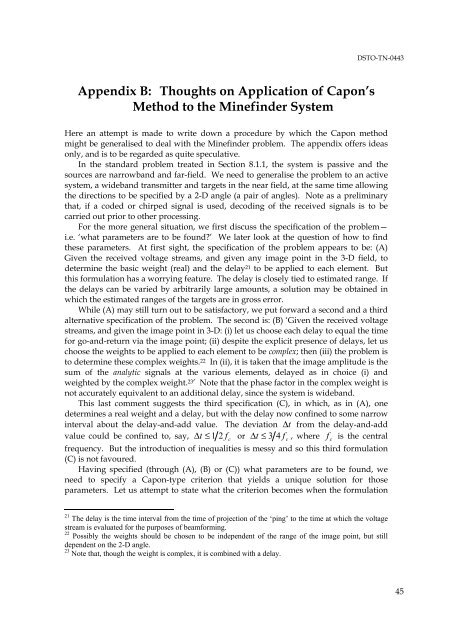Suitability of Correlation Arrays and Superresolution for Minehunting ...
Suitability of Correlation Arrays and Superresolution for Minehunting ...
Suitability of Correlation Arrays and Superresolution for Minehunting ...
Create successful ePaper yourself
Turn your PDF publications into a flip-book with our unique Google optimized e-Paper software.
DSTO-TN-0443<br />
Appendix B: Thoughts on Application <strong>of</strong> Capon’s<br />
Method to the Minefinder System<br />
Here an attempt is made to write down a procedure by which the Capon method<br />
might be generalised to deal with the Minefinder problem. The appendix <strong>of</strong>fers ideas<br />
only, <strong>and</strong> is to be regarded as quite speculative.<br />
In the st<strong>and</strong>ard problem treated in Section 8.1.1, the system is passive <strong>and</strong> the<br />
sources are narrowb<strong>and</strong> <strong>and</strong> far-field. We need to generalise the problem to an active<br />
system, a wideb<strong>and</strong> transmitter <strong>and</strong> targets in the near field, at the same time allowing<br />
the directions to be specified by a 2-D angle (a pair <strong>of</strong> angles). Note as a preliminary<br />
that, if a coded or chirped signal is used, decoding <strong>of</strong> the received signals is to be<br />
carried out prior to other processing.<br />
For the more general situation, we first discuss the specification <strong>of</strong> the problem—<br />
i.e. ‘what parameters are to be found?’ We later look at the question <strong>of</strong> how to find<br />
these parameters. At first sight, the specification <strong>of</strong> the problem appears to be: (A)<br />
Given the received voltage streams, <strong>and</strong> given any image point in the 3-D field, to<br />
determine the basic weight (real) <strong>and</strong> the delay 21 to be applied to each element. But<br />
this <strong>for</strong>mulation has a worrying feature. The delay is closely tied to estimated range. If<br />
the delays can be varied by arbitrarily large amounts, a solution may be obtained in<br />
which the estimated ranges <strong>of</strong> the targets are in gross error.<br />
While (A) may still turn out to be satisfactory, we put <strong>for</strong>ward a second <strong>and</strong> a third<br />
alternative specification <strong>of</strong> the problem. The second is: (B) ‘Given the received voltage<br />
streams, <strong>and</strong> given the image point in 3-D: (i) let us choose each delay to equal the time<br />
<strong>for</strong> go-<strong>and</strong>-return via the image point; (ii) despite the explicit presence <strong>of</strong> delays, let us<br />
choose the weights to be applied to each element to be complex; then (iii) the problem is<br />
to determine these complex weights. 22 In (ii), it is taken that the image amplitude is the<br />
sum <strong>of</strong> the analytic signals at the various elements, delayed as in choice (i) <strong>and</strong><br />
weighted by the complex weight. 23 ’ Note that the phase factor in the complex weight is<br />
not accurately equivalent to an additional delay, since the system is wideb<strong>and</strong>.<br />
This last comment suggests the third specification (C), in which, as in (A), one<br />
determines a real weight <strong>and</strong> a delay, but with the delay now confined to some narrow<br />
interval about the delay-<strong>and</strong>-add value. The deviation ∆ t from the delay-<strong>and</strong>-add<br />
value could be confined to, say, ∆ t ≤ 1 2 f<br />
c<br />
or ∆ t ≤ 3 4 f<br />
c<br />
, where f c<br />
is the central<br />
frequency. But the introduction <strong>of</strong> inequalities is messy <strong>and</strong> so this third <strong>for</strong>mulation<br />
(C) is not favoured.<br />
Having specified (through (A), (B) or (C)) what parameters are to be found, we<br />
need to specify a Capon-type criterion that yields a unique solution <strong>for</strong> those<br />
parameters. Let us attempt to state what the criterion becomes when the <strong>for</strong>mulation<br />
21 The delay is the time interval from the time <strong>of</strong> projection <strong>of</strong> the ‘ping’ to the time at which the voltage<br />
stream is evaluated <strong>for</strong> the purposes <strong>of</strong> beam<strong>for</strong>ming.<br />
22 Possibly the weights should be chosen to be independent <strong>of</strong> the range <strong>of</strong> the image point, but still<br />
dependent on the 2-D angle.<br />
23 Note that, though the weight is complex, it is combined with a delay.<br />
45

















